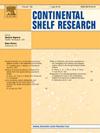第聂伯河-布赫河羽流:非潮汐海域大量淡水排放的故事
IF 2.1
3区 地球科学
Q2 OCEANOGRAPHY
引用次数: 0
摘要
第聂伯河是欧洲河流中年平均排水量第二大的河流,它与 Pivdennyi Buh 河一起流向黑海西北大陆架,形成第聂伯河-Buh 沿岸浮力羽流。本研究介绍了 1992 年和 1994 年 5 月对第聂伯河-布赫河羽流的船上观测结果,当时淡水排 放量分别低于和高于 5 月份的气候值,而风力较小,且变化不定。后来在类似条件下获得的卫星图像补充了现场数据。第聂伯河-布河口的弱混合导致形成了一个 1.5-3 米深的薄表面对流羽流。河口流出的气流与海岸线平行,但随着下游距离的增加,它迅速向近海扩展,形成多个巴氏罗斯比半径。在同步到月度时间尺度上,第聂伯河-布赫河羽流在河口的上游和下游都以双峰方式扩散。羽流中淡水的下游地转输送量仅占哺育羽流的淡水排放量的一小部分。此外,随着近海盐度异常的减小,淡水含量几乎保持不变,甚至有所增加。这意味着淡水扩散在更大程度上是通过跨锋面 "扩散 "来维持的,而不是通过与羽流相关的地转环流的吸附。中尺度和次中尺度的不稳定性很可能在第聂伯河-布赫河羽流的混合和离岸扩散过程中发挥了重要作用。本文章由计算机程序翻译,如有差异,请以英文原文为准。
The Dnipro-Buh plume: A tale of high-volume freshwater discharge in a non-tidal sea
The Dnipro River has the second-largest annually-averaged discharge among European rivers and together with the Pivdennyi Buh River runs off on the Black Sea northwestern shelf, forming the Dnipro-Buh coastal buoyant plume. This study presents shipboard observations of the Dnipro-Buh plume in May of 1992 and 1994, when the freshwater discharge was lower and higher, respectively, than its climatological value for May, while the wind forcing was light and variable. In-situ data are complemented with satellite images obtained under similar forcing conditions at later times. Weak mixing in the Dnipro-Buh estuary leads to the formation of a thin, 1.5–3 m deep surface-advected plume. The estuarine outflow runs off parallel with the coastline, but with downstream distance it rapidly expands offshore over multiple baroclinic Rossby radii. On synoptic to monthly time scales, the Dnipro-Buh plume spreads in bimodal fashion, both upstream and downstream from the estuarine mouth. The downstream geostrophic transport of freshwater in the plume is a small fraction of the freshwater discharge feeding the plume. Also, as salinity anomaly decreases offshore, the freshwater content remains near-constant or even increases. This implies that the freshwater spreading is sustained by cross-frontal “diffusion” to a greater extent than through the advection by geostrophic circulation associated with the plume. Meso- and submesoscale instabilities are likely to play a major role in mixing and offshore spreading of the Dnipro-Buh plume.
求助全文
通过发布文献求助,成功后即可免费获取论文全文。
去求助
来源期刊

Continental Shelf Research
地学-海洋学
CiteScore
4.30
自引率
4.30%
发文量
136
审稿时长
6.1 months
期刊介绍:
Continental Shelf Research publishes articles dealing with the biological, chemical, geological and physical oceanography of the shallow marine environment, from coastal and estuarine waters out to the shelf break. The continental shelf is a critical environment within the land-ocean continuum, and many processes, functions and problems in the continental shelf are driven by terrestrial inputs transported through the rivers and estuaries to the coastal and continental shelf areas. Manuscripts that deal with these topics must make a clear link to the continental shelf. Examples of research areas include:
Physical sedimentology and geomorphology
Geochemistry of the coastal ocean (inorganic and organic)
Marine environment and anthropogenic effects
Interaction of physical dynamics with natural and manmade shoreline features
Benthic, phytoplankton and zooplankton ecology
Coastal water and sediment quality, and ecosystem health
Benthic-pelagic coupling (physical and biogeochemical)
Interactions between physical dynamics (waves, currents, mixing, etc.) and biogeochemical cycles
Estuarine, coastal and shelf sea modelling and process studies.
 求助内容:
求助内容: 应助结果提醒方式:
应助结果提醒方式:


